We sincerely hope that each of you, our readers, will enjoy and appreciate this article we present about these 4 Remarkable Louisiana Reptiles. It was certainly our great pleasure to gather the information for you. May it serve to provide you with both education and increased awareness.
Certainly, these few incredible species listed herein represent only a miniscule portion of the similar marvels found in the oceans. It’s our belief, though, that they serve as excellent representations of the wonders that exist. Check out some of our many other articles for similar marvels.
Eastern Diamondback Rattlesnake
Eastern Diamondback Rattlesnake Facts
- Starting off this article about these 4 Remarkable Louisiana Reptiles we present the powerful creature best known as the Eastern Diamondback Rattlesnake.
- Notably, the name given to this marvel applies to a reptile that’s a highly venomous species of pit viper. Among professionals, such as researchers, though, its more frequently known by its technical name of the Crotalus adamanteus.
- It received that name due to the work of the respected French naturalist, Ambroise Marie François Joseph Palisot. He made the first formal recogntion of the reptile as a separate and distinct species. This noteworthy action he accomplished in 1799.
- This dangerous but magnificent rattlesnake also holds another impressive status. That’s because it ranks as the heaviest venomous snake on two continents. Despite its great weight, however, the animal does not qualify as the longest of them.
- For a variety of reasons, the IUCN currently lists it as a species of Least Concern on its Red List. This status currently remains under review, however. This reconsideration occurs due to ongoing changes in conditions within the range of the snake.
- Estimates put its population at 3% of what it once was. Habitat loss and highway mortality, plus a low reproductive rate form the main factors in its decline. Climate change also threatens the Eastern Diamondback Rattlesnake, as well.
Eastern Diamondback Rattlesnake Physical Description
The amazing creation of nature and evolution named the Eastern Diamondback Rattlesnake easily constitutes a physically imposing reptile. It holds this claim due to a very specific reason, though. That’s due to its sheer massiveness, for a venomous reptile.
Variations in size between individuals do sometimes,occur, however. This holds true partly due to the fact that this amazing creature displays a slight degree of the physiological characteristic of sexual dimorphism. In this, it’s like most of its relatives, though.
In its case, this principle manifests in terms of overall size. The male typically attains a slightly greater length and weight than the female. The difference remains quite small, though. Due to this, the two genders are usually considered to be of the same size.
A typical length for this incredible reptile thus equals roughly 5.5 ft (1.7 m). The typical adult generally weighs about 10 lb (4.5 kg). Yet, exceptional specimens occasionally reach lengths equaling as much as 7.8 ft (2.4 m). Most of the exceptional-sized individuals are male.
The Eastern Diamondback Rattlesnake also presents a striking image in color pattern. That’s because this typically consists of shades of brown, yellow, gray, and olive. This pattern develops overlaid with a series of 24-35 black or dark brown diamond shapes.
- Kingdom: Animalia
- Phylum: Chordata
- Class: Reptilia
- Order: Squamata
- Family: Viperidae
- Genus: Crotalus
- Species: C. adamanteus
Eastern Diamondback Rattlesnake Distribution, Habitat, and Ecology
Unfortunately for those who appreciate Nature, the Eastern Diamondback Rattlesnake evolved as endemic to a very limited territorial range. This native zone of habitation only includes the southeastern United States. Even there, it only appears in a limited area, though.
More specifically, due to these limitations, its natural range only extends along the coastal plain. More specifically, that runs from eastern North Carolina to southeastern Louisiana. The snake further inhabits some portions of the range in greater numbers than others.
Due to this natural tendency, the increasingly rare animal appears to be most numerous in the states of Alabama and Georgia. Unfortunately for those who love Nature, the reptile’s now offically considered to be extinct in the states of North Carolina and Louisiana.
It’s best known for its relative toxicity. A typical bite produces 3-4 times the amount of venom needed to kill an average human. Antivenom is available in most medical facilities throughout its range, however. Therefore, attacks usually only become fatal if untreated.
The dangerous but impressive animal also remains quite adaptable in character. In point of fact, it frequently shows that it will inhabit a wide range of habitat types. These regions include pine forests, sandhills, coastal hammocks, and most types of swampy areas.
The Eastern Diamondback Rattlesnake also displays yet another distinctive characteristic. This intriguing animal typically resides within burrows previously excavated by other animals. From there, it forages for prey, mainly consisting of smaller animals.
American Alligator
American Alligator Facts
- Next up among our choices for inclusion in this compendium of 4 Remarkable Reptiles of Louisiana is the awesome wonder named the American Alligator.
- This remarkable product of evolution remains best known by the informative and descriptive common name that we’ve used herein. Yet, it has a few other general titles, too. These include such simple terms as common alligator, and gator.
- Within the scientific community, however, it’s perhaps better known by its technical designation. As so often holds true, though, that’s something of a tongue-twister for the layperson. That’s because it holds the official epithet Alligator mississippiensis.
- The impressive creature received that moniker due to the efforts of François Marie Daudin. The noted French zoologist accomplished the first recognition of it as a separate and distinct species. He managed that scientifically noteworthy deed in 1802.
- This amazing reptile represents one of only two surviving members of its genus. It’s also the larger of the two. In the distant past, however, the world held several other species within this genus. One, extinct millions of years ago, reach 39 ft (11.9 m)!
- Considered endangered as recently as the 1960’s, the population of the awesome American Alligator recovered due to conservation efforts. Due to the result of those concerted efforts, the IUCN currently lists the animal as Least Concern on its Red List.
- The marvel of Nature nevertheless still faces multiple potential threats to its continued existence as a species. Like all forms of life on the earth today, most of those stem from the actions of man. They include the related perils of habitat loss and climate change.
American Alligator Physical Description
The breathtaking American Alligator certainly captures the attention of those who encounter it. This holds true both in reality and in culture. Unlike some creatures, though, this incredible creation of Nature merits appreciation both for its beauty and its physical size.
In terms of its physical nature, the intriguing Crocodilian follows a pattern of development similar to most others. That’s in the simple fact that it displays a certain amount of the physiological trait known as sexual dimorphism. In its case, this manifests in dimensions.
More precisely, males attain greater average measurements than their female counterparts. This trend extends to both length and weight. Although this gender-based difference presents as less extreme than in many of its relatives, it’s nonetheless still quite notable.
Males attain an average total length equaling about 11.2 ft (3.4 m). Weights for these same individuals measures a mean of 790 lb (360 kg). Exceptional examples exceed both these significantly, though. Some grow to as much as 15.1 ft (4.6 m) and 1,100 lb (500 kg).
Females, meanwhile, reach smaller dimensions in both respects. For this sex, mature individuals manage an average total length of roughly 8.5 ft (2.6 m). Their mass also remains less, typically averaging about 201 lb (91 kg). They’re clearly much slimmer than males.
Otherwise, however, the genders of the American Alligator present the same outward appearance to the observer. The upperside of the body generally displays a range of colors that include brown, gray, black, or olive. The underside, though, usually shows a cream color.
Like its many kindred around the world, its body has a covering of thick, sturdy scales. It’s also well known for its elongated snout. This contains 74 – 80 short yet powerful teeth. It also has relatively short legs. Its front legs develop five toes, but the rear one’s only have four.
- Kingdom: Animalia
- Phylum: Chordata
- Class: Reptilia
- Order: Crocodylia
- Family: Alligatoridae
- Genus: Alligator
- Species: A. mississippiensis
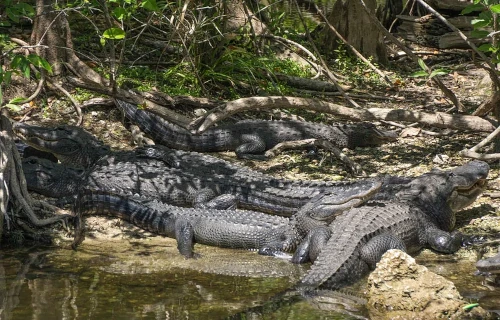
American Alligator Distribution, Habitat, and Ecology
The astounding American Alligator evolved as native to a relatively small expanse of the surface of the earth. Its own name provides information as to where that zone of habitation lies, though. As indicated, the animal is endemic to a small portion of North America.
Within the confines of that continent, however, it only appears naturally in a specific territorial range of the United States. There, it appears in the southeastern region. Its range extends from as far north as North Carolina to as far south as Texas and Oklahoma.
The impressive reptile displays a moderate degree of flexibility regarding its choice of habitat type. Due to this adaptability, it’s seen in a variety of localities and ecosystems. Yet, the wonder of Nature principally resides in streams, rivers, swamps, lakes, and ponds.
The greatest concentration of the animal occurs in Louisiana, followed by the Everglades, in Florida. Although they prefer freshwater, it’s sometimes spotted in brackish water. Amazingly, it’s also shown a willingness to live in the water hazards of golf courses!
As with all related creatures, the American Alligator evolved as a carnivore. It hunts both actively and as an ambush predator. It also feeds opportunistically and indiscriminately. Its diet ranges from small invertebrates to fish, birds frogs, and small mammals.
Breeding takes place in early spring, after which the female lays 20 – 50 eggs in a nest she constructed near the water. Incubation takes about 65 days, during which time the mother remains close by. After hatching, she carries them to the water in her jaws.
Rainbow Snake
Rainbow Snake Facts
- Now appearing in this gathering of 4 Remarkable Reptiles of Louisiana comes the colorful work of evolution that goes by the name of the Rainbow Snake.
- The descriptive term it’s known by serves as the most frequently used common name for this visually stunning reptile. The name also suits the creature perfectly. Its other common name, the eel moccasin, remains much less colorfully descriptive.
- Its scientific name, meanwhile, is somewhat difficult to pronounce. That’s because it bears the cumbersome appellation of Farancia erytrogramma. This tongue-twisting name further derives from the ancient Greek word of erythros, meaning red.
- The first official recognition of the animal as a separate and distinct species, however, did not occur until much later. In fact, it wasn’t until 1802. This took place as a direct result of the work of the renowned French naturalist, Palisot de Beauvois.
- Previously, scientists also recognized a total of two separate subspecies of the marvelous snake. Sadly, however, researchers later declared one of those as extinct. The Farancia erytrogramma, therefore, now represents the sole example of the species.
- Quite fortunately for those who appreciate its beauty, the population of the Rainbow Snake appears to be both stable and sufficient. This further holds true throughout the entirety of its natural range. The IUCN, therefore, currently lists it as Least Concern.
- It nevertheless does face some potential threats. In this it reflects the current state of environmental factors around the world. Habitat loss due to human encroachment threatens it, of course. Its greatest threat, though, comes from climate change.
Rainbow Snake Physical Description
The Rainbow Snake impresses those encounter it in several ways. The first of those occurs due to its sheer physical size. That’s due to the fact that this particular reptile attains a moderately great length. It also displays a moderate degree of the trait of sexual dimorphism.
In this specific species, the trait manifests itself in regards to gender size. More specifically, though, this results in females reaching greater average lengths than that of the males. The overall size difference, however, remains comparatively minor in most specimens.
Overall, the gorgeous Rainbow Snake reaches as an impressive average length. In point of fact, this length typically equals between roughly 36 – 48 in (91 – 122 cm). Exceptional individuals, however, sometimes grow to recorded lengths of as much as 66 in (168 cm).
Its most striking feature, though, remains its physical appearance. This, in fact, results in the common name. That’s because it displays an incredible pattern of colors. Most display a glossy bluish-black hue, on smooth scales. It further possesses three bright red stripes.
Mature adults, however, occasionally display a pattern of pale yellowish coloring. This most frequently appears on the head and along the sides of the beautiful animal. It also has a relatively short tail, tipped with a spiny tip, often used to probe its surroundings.
- Kingdom: Animalia
- Phylum: Chordata
- Class: Reptilia
- Order: Squamata
- Family: Colubridae
- Genus: Farancia
- Species: F. erytrogramma
Rainbow Snake Distribution, Habitat, and Ecology
Most unfortunately, the dazzling Rainbow Snake presently only inhabits a comparatively small section of the globe. It also currently remains unknown to researchers if the magnificent, and often misunderstood, animal ever possessed a more extensive range.
Regardless of the unknowns, its current zone of habitation remains restricted to a small portion of North America. In point of fact, this consists of a tiny section of the United States. More precisely, it appears in an area that runs along the east and southeast portion.
There, the remarkable reptile lives in a total of 8 of the southern states. These consist of Maryland, Virginia, North Carolina, South Carolina, Georgia, Florida, Alabama, and Louisiana. Even there, though, it only inhabits the regions closer to the coast.
The breathtakingly colored Rainbow Snake also evolved as a primarily aquatic creature in nature. As a result, the fascinating animal has decidedly specific habitat preferences. Individuals therefore most commonly appear in areas that reflect that specific characteristic.
Specimens most often live in regions that include swamps, slow-moving bodies of water, such as small creeks and streams. It does, however, also appear in areas of open marsh. These environments appear in areas of deciduous forests, mountains, and sandy sections.
The principally nocturnal Rainbow Snake evolved as a skilled swimmer, catching most of their prey in the water. After catching that prey, however, it holds it in its mouth until reaching land. Once there, it swallows it whole. Many species prey on it in return, though.
Alligator Snapping Turtle
Alligator Snapping Turtle Facts
- Closing out this compilation of 4 Remarkable Reptiles of Louisiana is the seeming almost prehistoric marvel named the Alligator Snapping Turtle.
- This visually astonishing product of natural evolution most frequently goes by the descriptive and informative common name for understandable reasons. For the moment, it has no other widely accepted general name. But then, this one says it all.
- Among herpetologists, though, it’s typically referred to by its formal moniker. That, like so many others, however, is hard for the layperson to pronounce. That’s because this wonder of Nature bears the technical title of Macrochelys temminckii.
- The animal received this title due to the efforts of the respected Dutch-American naturalist, Gerardus Troost. He accomplished the first formal recognition of it as a separate and distinct species. This scientifically noteworthy action occurred in 1835.
- Regardless of which name one chooses to use, it’s an extraordinary creature. It represents the largest known variety of freshwater turtle on the continent it appears on. Though not a close relative, it’s often associated with the common snapping turtle.
- Sadly, the population of this marvel continues to decline. This unfortunate situation also seem to hold true throughout the entirey of its native range. Due to this trend, the IUCN presently lists the remarkable reptile as Vulnerable on its published Red List.
- The Alligator Snapping Turtle faces multiple threats to its existence. It’s hunted for its flesh, and is also popular in the exotic pet trade. Habitat loss due to human expansion, also endangers it. It also now finds itself facing the danger of climate change.
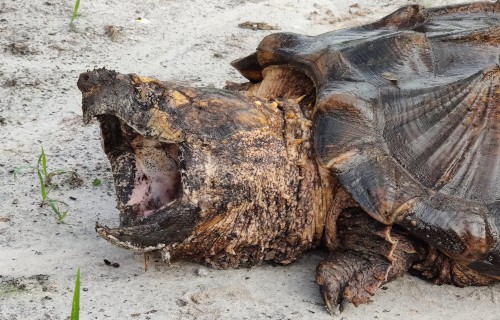
Alligator Snapping Turtle Physical Description
The amazing Alligator Snapping Turtle immediately captures the attention of those who encounter it. Not surprisingly, though, it does so for several reasons. Its pure appearance obviously startles most people. Yet it also impresses one with its sheer physical size.
Like many reptiles, it also displays a certain degree of the physiological trait of sexual dimorphism. In its case, however, this characteristic manifests itself in terms of length and mass. It also does so to a relatively great degree. Males attain much greater measurements.
Fully mature adults average a carapace length ranging from 13. 8 – 31.8 in (35 – 80.8 cm). Males tend to be on the higher end of that range, while females typically hold down the lower end. Exceptional individuals of both genders do sometimes occur, of course.
Average weights also vary widely, in keeping with this pattern. Females average closer to 19 lb (8.4 kg). Their male counterparts, meanwhile, average 176 lb (80 kg). An unconfirmed male specimen, though, reportedly achieved an astounding weight totaling 403 lb (183 kg)!
The heaviest confirmed example, a male, weighed 249 lb (113 kg). Except for the size difference, the two sexes appear nearly indistiguishable. They’re known for the three ridges of large scales on the thick shells. This shows a mix of gray, brown, black, or olive green.
Yet the remarkable Alligator Snapping Turtle evolved even more intriguing physical adaptations. The large, heavy head has a sharp beak. Even the inside of the mouth is camouflaged. Used to lure fish, a worm-like appendage appears on the tip of the tongue.
- Kingdom: Animalia
- Phylum: Chordata
- Class: Reptilia
- Order: Testudines
- Family: Chelydridae
- Genus: Macrochelys
- Species: M. temminckii
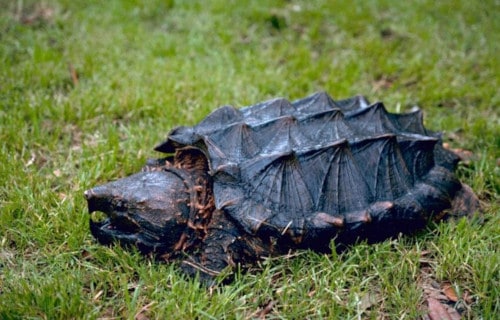
Alligator Snapping Turtle Distribution, Habitat, and Ecology
The attention-grabbing Alligator Snapping Turtle evolved as native to a moderately limited region of the world. The precise location of that swathe of the globe, however, might surprise some people. That’s because it developed as endemic to a portion of North America.
There, its zone of habitation falls within the confines of the United States. Even there, though, it only appears natively in the southeastern regions of the country. That range extends from Florida west to Texas. From Louisiana that extends north as far as Indiana.
The vast majority of specimens, live in the more southern parts of that range, though. Yet, in all areas it lives in, the animal displays extreme preferences in its choice of habitat. The reptile is typically only found in bodies of water that flow into the Gulf of Mexico.
This does include several types of smaller ecosystems, however. That includes areas of creeks, lakes, marshes, canals, and slow-moving rivers. The creature also prefers the presence of beaver dens, submerged dead trees, shrubs, and low-hanging trees.
Not surprisingly, the Alligator Snapping Turtle evolved as a carnivore. It’s also a highly opportunistic feeder. It both actively hunts for prey, and scavenges dead organisms. As a general principle, this powerful creature consumes virtually anything it can catch.
The main components of its diet consist of fish, amphibians, mollusks, and carrion. But it’s also known to consume snail, snakes, worms, insects, and crawfish. It even consumes the occasional plant. Larger individuals even eat such prey as birds, squirrels, and opossums!
4 Remarkable Louisiana Reptiles
It’s our fervent hope that each of you enjoyed reading, and hopefully learning from, this article we’ve written for you about these 4 Remarkable Louisiana Reptiles. It’s also our hope that doing so has left you with either a new or fully renewed appreciation for such wonders of Nature.
Unfortunately, however, many of their numerous kindred around the world now find themselves facing strong threats to their continued existence as a species. Many of those dangers, in fact, stem from the actions of mankind. We must do all that we can to protect and preserve them all.
Check out our other articles on 5 Pleasing Insects of Portugal, Cape Porcupine, 5 Fabulous Flora of Germany, East African Lowland Honey Bee, 5 Terrific United States Trees
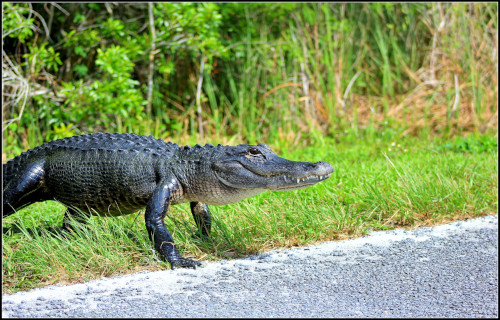
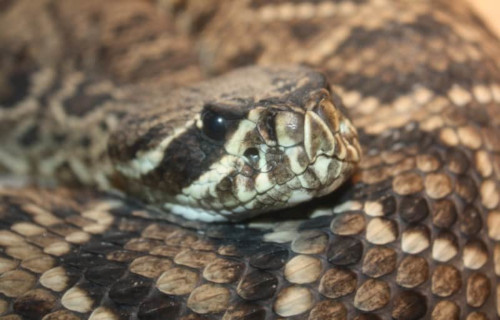
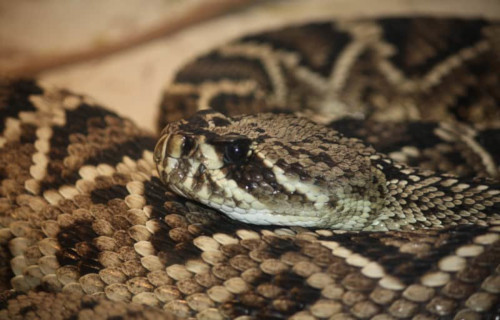
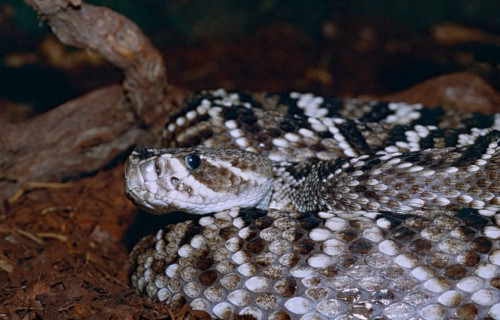
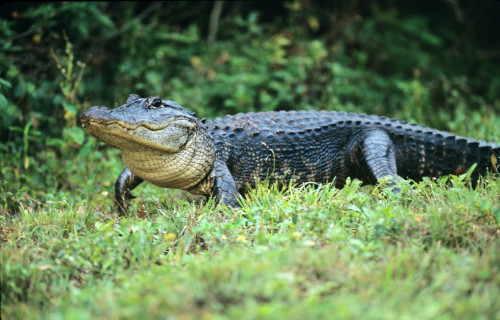
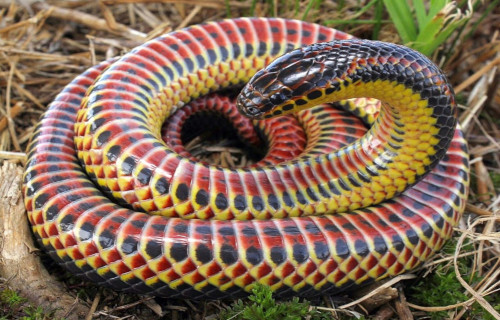
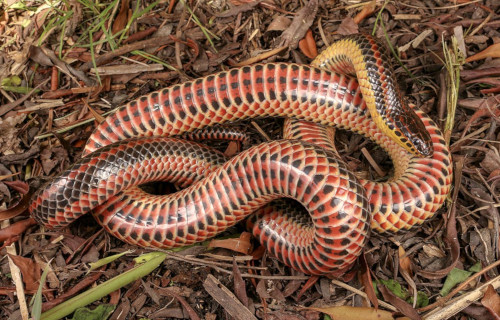
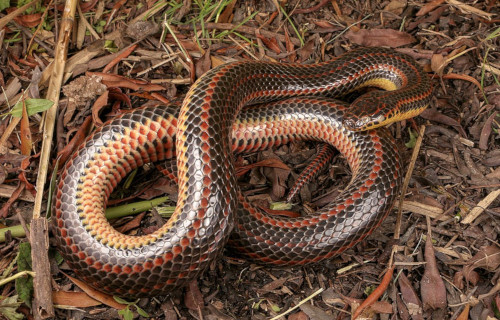
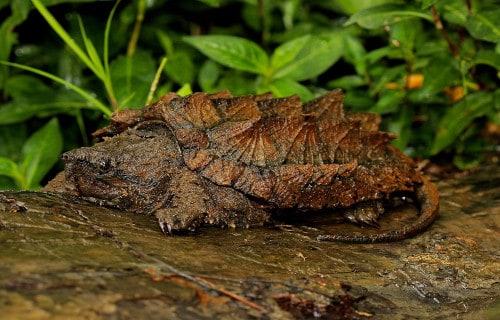









Leave a Reply